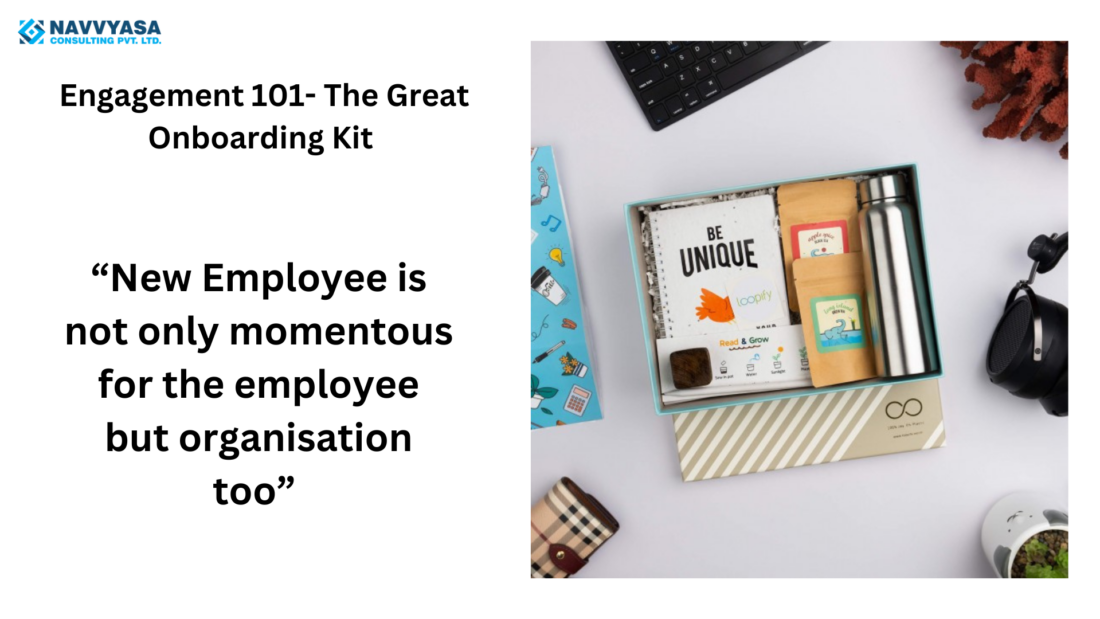The first footsteps in the organization if marked with apathy or regularity, lead to disengagement early on. There is no two ways about it that having a great onboarding is vital to welcoming new employees. It is about giving them all the resources that help them perform and settle in the organization.
During the peak of COVID, great onboarding meant a great Onboarding Kit. From fancy tumblers to t-shirts to sleek gadgets, organizations were going above and beyond to give that personal touch which was lacking due to the remoteness of employees. Now, even though a standard practice the oomph has gone from the Onboarding Kit.
As we enter the era of Back to Office, the onboarding kits are slowly making way for a more personalized touch at offices, from lunches to buddy programs and regular check-ins during hyper-care (first 90 days) period.
The question I posit is whether Onboarding Kit or Not?
Well, a good onboarding has to have two parts – 1. Introduction of the Company and Policies. Honestly, if an employee is not told of all HR policies on Day 1, there will never be another day. Company values and business propositions are the secondary agenda on the list. Even if the employee connects 10% on the first day it is enough to tether them to the organisation.
Also, good preparedness on the first day takes it to a whole another level- get their emails, IDs, and other resources pooled before they join and you are looking at a streamlined onboarding process. It doesn’t need a band or a welcoming crew, but a good step-by-step process to induct a new employee.
One of my best onboarding I think was with my first company, we got a three-day induction with leadership and understood what the company stood for. If someone asked me today what is TCOC I might still be able to tell all and it has been almost 8 years since I left that organisation.
Instilling values is a long-drawn process and requires effort at every step. But once it becomes a standard practice it is easier to replicate at mass scale.
It is harder to do so remotely, so an onboarding kit helps build that moment of happiness with the employee but alas as we move to more office setup, we are doing less of these.
So perhaps smaller mementos are in order, a laptop with personalized stickers, a shipper, or perhaps a photo frame to keep on your desk. A small knick-knack helps the employee feel their desk is their own but also reinforces that being a new part of the organization is momentous for the organization too.
A small effort towards making your onboarding standard and special is all you need for it to leave an impression that helps the employee navigate the first week jitters and make them feel at ease.
The Modern Hiring Dilemma: When Silence Speaks Louder Than Words
In today’s competitive job market, effective communication is paramount. Yet, a troubling trend has emerged among hiring managers: the lack of timely feedback and engagement with recruitment vendors and candidates. This not only hampers the recruitment process but also tarnishes the employer’s brand.
The Ripple Effect of Delayed Feedback: When recruitment vendors submit profiles, timely feedback is crucial. Candidates invest time and effort in interviews, and the expectation is that hiring managers will reciprocate with constructive input. Unfortunately, many hiring managers remain silent or take weeks to respond, leaving both candidates and consultants in limbo. This lack of communication can lead to frustration and disengagement from top talent.
The Irony of Urgency: Adding to this dilemma, hiring managers often turn to consulting companies with a sense of urgency, demanding candidates “as of yesterday.” They expect a quick turnaround while failing to provide the same urgency in their feedback and decision-making. This disconnect creates a frustrating cycle where candidates feel undervalued and left waiting, only to be met with irritation when they pursue other opportunities.
Holding Candidates Hostage: Even more concerning is the tendency for hiring managers to keep candidates hanging without a clear timeline. Candidates are often left waiting for an offer that may never come, causing them to explore other opportunities. When these candidates inevitably receive another offer, hiring managers often react with annoyance, despite having contributed to the situation through their inaction.
The Cost of Poor Communication: In a time when top talent is scarce, this behavior can have dire consequences. Companies may find themselves losing out on qualified candidates who feel undervalued and unappreciated. Moreover, a reputation for poor communication can deter future applicants, impacting the overall talent pool.
A Call to Action: As we navigate this fast-paced hiring landscape, it’s essential for hiring managers to prioritize communication. Providing timely feedback, setting clear expectations, and respecting candidates’ time can foster a more positive hiring experience for everyone involved.
Let’s work together to create a recruitment environment that values transparency and respect. After all, in the world of talent acquisition, every interaction counts. Let’s ensure that silence doesn’t overshadow opportunity!
Why Leaders Need to Hire Their “A” Team?
In the world of talent acquisition, one golden rule stands out: “A” teams hire “A” players, while “B” teams hire “C” players. This principle highlights the crucial importance of building a top-tier team from the very beginning. Here’s why leaders should always aim for their “A” team:
1. Excellence Breeds Excellence
“A” players are high achievers who set and maintain high standards. They inspire and challenge their peers, creating a culture of excellence. This domino effect ensures your team consistently performs at its best.
2. Innovation and Growth
Top talent thrives on innovation and creativity. “A” players are not just problem solvers but also visionaries who push the boundaries, leading to groundbreaking solutions and continuous growth for your organization.
3. Strong Leadership Pipeline
Hiring “A” players creates a strong pipeline for future leaders. These individuals possess the skills and mindset needed to step into leadership roles, ensuring your company’s long-term success and stability.
4. Positive Workplace Culture
An “A” team fosters a positive, collaborative, and dynamic work environment. They bring enthusiasm, dedication, and a can-do attitude, which boosts morale and employee engagement across the board.
5. Attracting More Talent
High-caliber professionals want to work with other top talents. By establishing an “A” team, you create a magnet for attracting more elite performers, perpetuating a cycle of excellence.
Avoid the “B” and “C” Team Trap
“B” players, while competent, often feel threatened by “A” players and thus hire “C” players to avoid being overshadowed. This creates a downward spiral in talent quality, leading to mediocrity and stagnation.
Your hiring decisions set the foundation for your company’s future. Prioritize assembling your “A” team, and watch your organization soar to new heights.
Hiring Gone Wrong?
One of the key factors, when we have discussions internally or with clients, is why hiring goes wrong in certain cases.
The question remains how do you qualify someone as a wrong hire?
It is especially true when someone doesn’t align with the culture and working environment and in some cases, the alignment of roles and performance doesn’t match.
-The Problem of Culture Fit?
One of the key ways to avoid this problem is to be extremely clear on who you are as a company and that can only happen if you can pinpoint your employer brand.
Ask your employees how they associate the company and what as a founder or captain of the company, how you perceive it. The amalgamation of these two will give you the answer.
Although a long interview process is exhausting, take that as a point of discussion- one round simply is not enough and one needs to understand who the candidate is and whether they thrive within the culture of the company. You can avoid a lot of Culture Fit mishaps by being open and transparent.
Make your interview process a discussion first process.
-The problem of performance-
Is the employee unable to perform basic duties or are you not providing the right tools?
In this case, have multiple rounds of discussion, and understand the pain points for them, and with resources provided, they most likely can perform and in the unlikely scenario that they still can’t perform, make a clean break.
Performance is indicative of both the organization and the employee. Introspection is very important but so is to understand when you cut your losses as an organization and as an employee.
Not even a match will work out, but if you look for the right behavioral traits and indicators, you are bound to find more matches that work in your favor.





